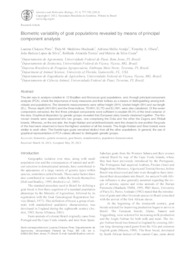Biometric variability of goat populations revealed by means of principal component analysis.
Biometric variability of goat populations revealed by means of principal component analysis.
Author(s): PIRES, L. C.; MACHADO, T. M. M.; ARAUJO, A. M. de; OLSON, T. A.; SILVA, J. B. L. da; TORRES, R. A.; COSTA, M. da S.
Summary: The aim was to analyze variation in 12 Brazilian and Moroccan goat populations, and, through principal component analysis (PCA), check the importance of body measures and their indices as a means of distinguishing among individuals and populations. The biometric measurements were wither height (WH), brisket height (BH) and ear length (EL). Thorax depth (WH-BH) and the three indices, TD/WH, EL/TD and EL/WH, were also calculated. Of the seven components extracted, the first three principal components were sufficient to explain 99.5% of the total variance of the data. Graphical dispersion by genetic groups revealed that European dairy breeds clustered together. The Moroccan breeds were separated into two groups, one comprising the Drâa and the other the Zagora and Rhâali breeds. Whereas, on the one side, the Anglo-Nubian and undefined breeds were the closest to one another the goats of the Azul were observed to have the highest variation of all the breeds. The Anglo-Nubian and Boer breeds were similar to each other. The Nambi-type goats remained distinct from all the other populations. In general, the use of graphical representation of PCA values allowed to distinguish genetic groups.
Publication year: 2012
Types of publication: Journal article
Unit: Embrapa Mid-North
Observation
Some of Embrapa's publications are published as ePub files. To read them, use or download one of the following free software options to your computer or mobile device. Android: Google Play Books; IOS: iBooks; Windows and Linux: Calibre.
Access other publications
Access the Agricultural Research Database (BDPA) to consult Embrapa's full library collection and records.
Visit Embrapa Bookstore to purchase books and other publications sold by Embrapa.

